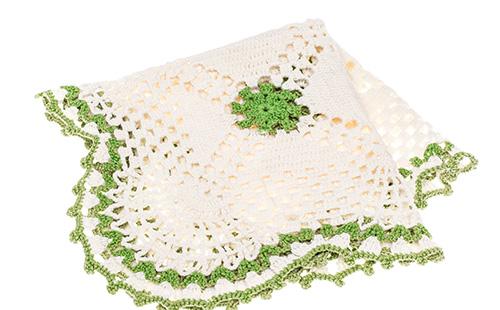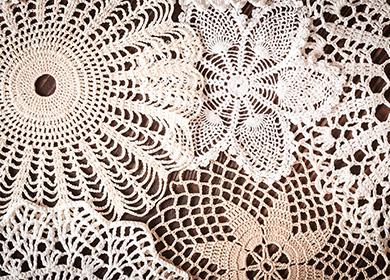The content of the article
How to starch crocheted snowflakes, collar, or basket? You can give them stiffness with PVA glue, or you can use the method that was tested by our grandmothers, which to this day has not lost its relevance - to starch. Remember our grandmothers in the house ironed and folded neatly in a closet, crocheted napkins and tablecloths, snow-white like swan wings? Want to know how such an unbeatable result was achieved? Read our article. And if you don’t like to read, at the end you will find a video where they will not only talk about the process, but also show what and how to do it.
For the manufacture of napkins, cotton threads are used, which may contain impurities of Lurex, silk or viscose. Naturally, soft fibers are deformed during operation. And if we are talking about openwork products, they can’t keep their shape at all without additional processing, namely starch. The result will be as follows:
- the fibers will become more dense;
- light products will become snow-white;
- a kind of barrier is formed that does not allow pollution to penetrate deep into the fibers.
How to starch a napkin: a classic way
The best option for starching a crocheted napkin is the classic method involving the use of potato starch. The tool is distinguished by its effectiveness and low cost. It was successfully used by our great-grandmothers, which inspires confidence.
Solution concentration
Depending on how stiff you want to make your napkin, it is important to correctly determine the concentration of starch. As can be seen from the following table, three degrees of fiber stiffness are distinguished.
Table - Options for the concentration of starch solution
| Solution | Amount of starch per liter of water | Characteristic | For what |
|---|---|---|---|
| Soft | - Tea spoon | - Gives fabric elasticity | - Napkins that should hang down; - tablecloths; - curtains |
| Average | - tablespoon | - Gives the fabric a shape, makes it crispy | - Lace; - cuffs and collars |
| Hard | - 2 tablespoons | - Gives fabric hardness | - Volumetric crafts (flowers, plates, vases) crocheted |
Starch Algorithm
There should be no impurities or debris in the starch. If you find that the product contains any extraneous inclusions, fill it with water and let it stand for several hours. A pure product will settle to the bottom, and the litter will float to the surface.
Stages of solution preparation
- In a separate container, mix the starch in a small amount of water. The mass should be homogeneous, without lumps, like liquid sour cream.
- Put the remaining water on the fire and boil.
- With a thin stream, introduce the starch solution into boiling water without stopping stirring.
- When the paste has a uniform texture, remove the pan from the heat and cool the composition.
Starching process
- To starch a napkin at home, pour the finished paste into a basin.
- Dip the product in liquid.Make sure that the item is completely saturated with the composition.
- Soak from five minutes to a quarter of an hour (time is determined individually based on the thickness of the threads).
- Remove the product and gently squeeze excess moisture out of it.
Potato starch can not be processed synthetic, woolen and silk products, as there is a risk of violation of the structure of the material. It is also not recommended to use this tool for dark and colored products.
Supplement table
If you want to give your decor items an even more dramatic look, starch alone may not be enough. To make your cotton napkin shine with white and take the right shape, add some additives to the recipe.
Table - Best Starch Additives
| Additive | Amount per liter of water | Application | Appointment |
|---|---|---|---|
| Salt | - pinch | - Add to the finished hot paste | - Gives fibers a glossy sheen |
| Milk | - Half a glass | - Boil with water before adding starch | - Gives products a matte finish |
| Sugar | - 3 tablespoons | - Heat water with sugar until crystals dissolve | - Increases rigidity |
Dry method
It happens that there is absolutely no time for complex manipulations. In this case, you can quickly starch the napkin with dry starch. Proceed in five steps.
- Cover the ironing board with paper, and lay a napkin on top.
- Sprinkle starch through a sieve.
- Spray with water from a spray bottle.
- Cover the finished product with a sheet of paper and iron it.
- Squeeze excess starch.

Alternative methods
Do not think that it is impossible to starch a crocheted colored napkin. Of course, starch will not work, because white stains may appear on the product. Therefore, you will have to resort to the alternative methods described in the table.
Table - Ways to starch a napkin without starch
| Means | Composition | Instruction manual | How to use | Note |
|---|---|---|---|---|
| Sugar | - 3 glasses of sugar; - 300 ml of water | - Connect the components; - heat until sugar dissolves | - Soak the product for 3-5 minutes | - A crafted item can become an insect treat |
| PVA glue | - glue; - equal amount of water | - Stir until smooth | - Soak the napkin and cover with foil | - Helps starch products up to stiffness |
| Gelatin | - A tablespoon of gelatin; - half a glass of water | - Connect the components; - after 10 minutes, melt the swollen gelatin in a water bath | - impregnate the product with the composition | - Does not crumble, suitable for bulk products |
Features of drying and ironing
To properly starch a napkin, it is important not only to prepare a high-quality solution, but also to dry the product well. This process has four key features.
- Position. After impregnation in a solution, the napkin needs to be laid out on a horizontal surface. Typically, the product is dried on an ironing board covered with a towel.
- Fixation. If you simply starch the napkin and then dry it, it can become deformed. To prevent this, straighten and lock the edges of the product. This can be done with invisible needles.
- Drying. Ideal is drying in direct sunlight or in a well-ventilated area.
- Ironing When the napkin is almost dry, cover it with several layers of gauze and warm it with an iron.
If you like to decorate your home with original knitted accessories, you just need to master the starch technique. So, if you dry the treated napkin on a convex surface, you will get an original openwork vase.And knowing how to starch a knitted napkin without starch, you can make crafts not only from white, but also from black and colored threads.

